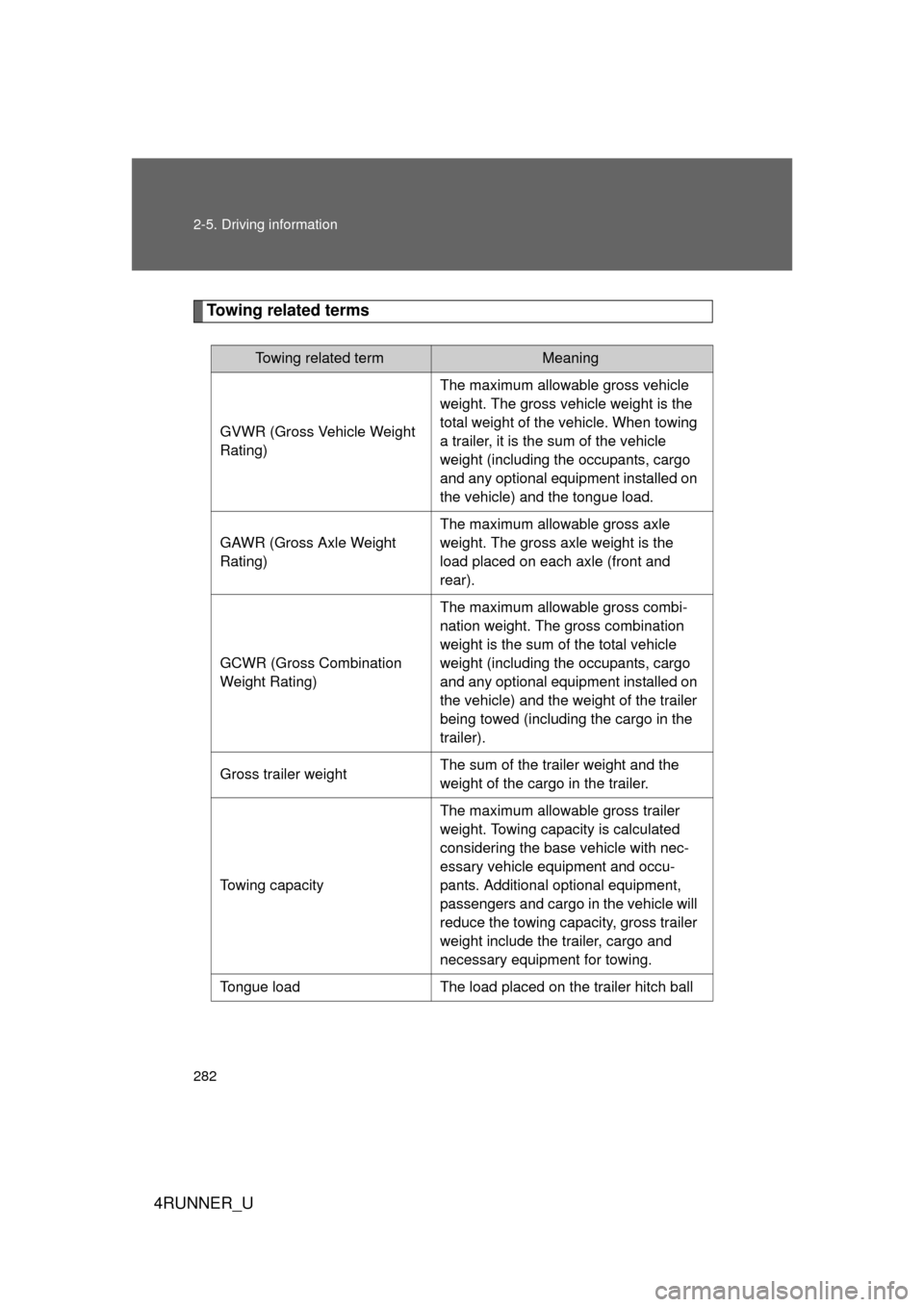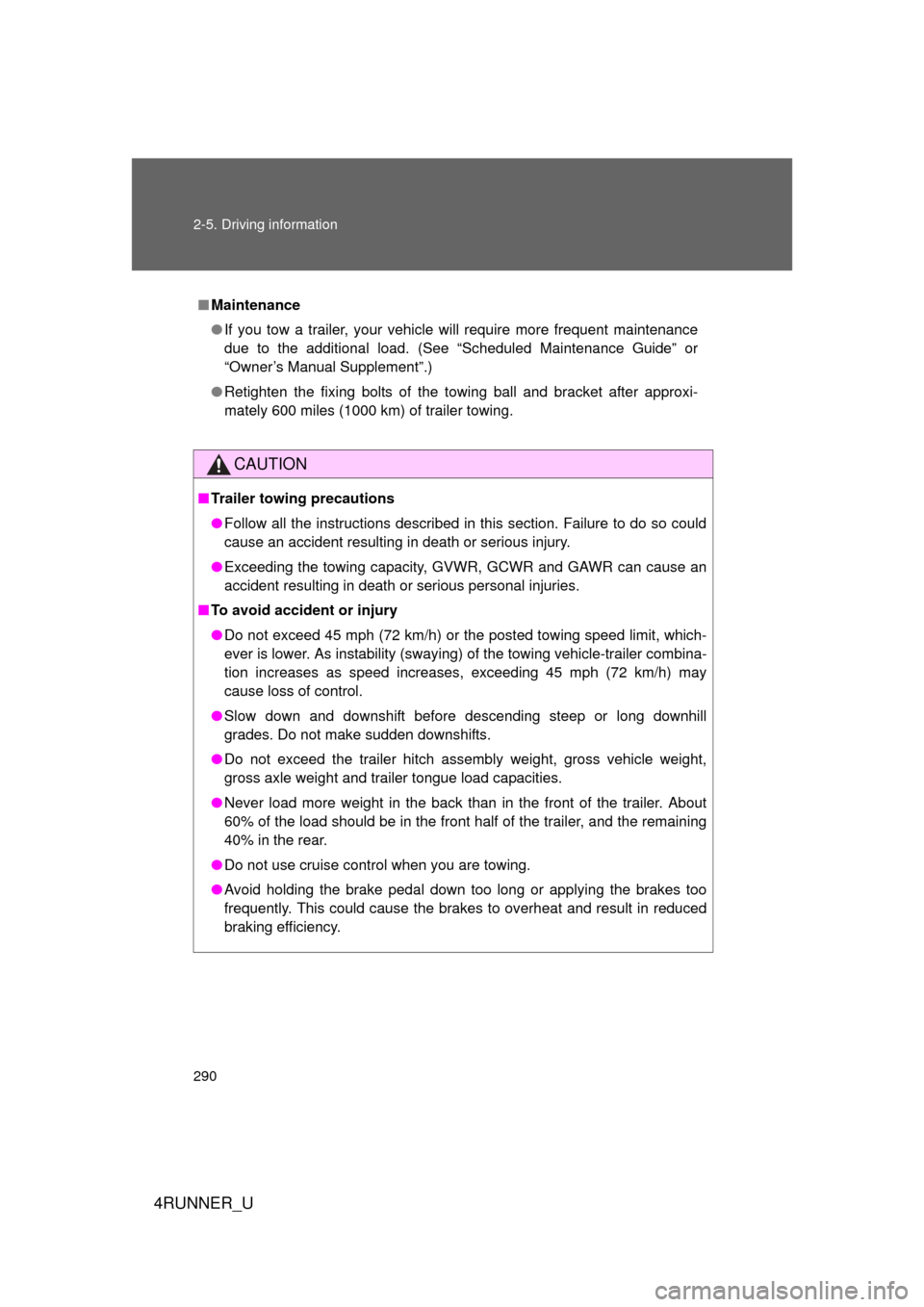Page 281 of 665
281
2-5. Driving information
2
When driving
4RUNNER_U
Weight limits
Confirm that the gross trailer weight, gross combination weight, gross
vehicle weight, gross axle weight and trailer tongue load are all within
the limits.
● The gross trailer weight must never exceed towing capacity
described in the table above.
● The gross combination weight must never exceed the GCWR
described in the table above.
●The gross vehicle weight must
never exceed the GVWR indi-
cated the Certification Label.
● The gross axle weight on each
axle must never exceed the
GAWR indicated the Certifica-
tion Label.
EngineDriving
systemTowing
capacityGCWR
2.7 L 4-cylinder
(2TR-FE) engine 2WD2000 lb.
(907 kg) 7900 lb. (3583 kg)
4.0 L V6 (1GR-FE) engine 2WD
5000 lb.
(2270 kg) 11100 lb. (5035 kg)
4WD 11300 lb. (5125 kg)
CTH61AS002
Page 282 of 665

282 2-5. Driving information
4RUNNER_U
Towing related terms
Towing related termMeaning
GVWR (Gross Vehicle Weight
Rating) The maximum allowable gross vehicle
weight. The gross vehicle weight is the
total weight of the vehicle. When towing
a trailer, it is the sum of the vehicle
weight (including the occupants, cargo
and any optional equipment installed on
the vehicle) and the tongue load.
GAWR (Gross Axle Weight
Rating) The maximum allowable gross axle
weight. The gross axle weight is the
load placed on each axle (front and
rear).
GCWR (Gross Combination
Weight Rating) The maximum allowable gross combi-
nation weight. The gross combination
weight is the sum of the total vehicle
weight (including the occupants, cargo
and any optional equipment installed on
the vehicle) and the weight of the trailer
being towed (including the cargo in the
trailer).
Gross trailer weight The sum of the trailer weight and the
weight of the cargo in the trailer.
Towing capacity The maximum allowable gross trailer
weight. Towing capacity is calculated
considering the base vehicle with nec-
essary vehicle equipment and occu-
pants. Additional optional equipment,
passengers and cargo in the vehicle will
reduce the towing capacity, gross trailer
weight include the trailer, cargo and
necessary equipment for towing.
Tongue load The load placed on the trailer hitch ball
Page 283 of 665
283
2-5. Driving information
2
When driving
4RUNNER_U
Trailer tongue load
● A recommended tongue load varies in accordance with the types
of trailers or towing as described below.
● In order to ensure the recommended values shown below, the
trailer must be loaded by referring to the following instructions.
The trailer cargo load should be di stributed so that the tongue load
is 9 to 11% of the gross trailer weight, not exceeding 500 lb. (227
kg).
(Tongue load / Gross trailer weight 100 = 9 to 11%)
If the gross trailer weight is over 2000 lbs. (907 kg), it is necessary
to use a sway control device with sufficient capacity.
The gross trailer weight and tongue l oad can be measured with plat-
form scales found at a highway weighing station, building supply
company, trucking company, junk yard, etc.
Gross trailer weight
Tongue load
Page 284 of 665
284 2-5. Driving information
4RUNNER_U
Hitch and tow hitch receiver■ Hitch
Trailer hitch assemblies have different weight capacities estab-
lished by the hitch manufacturer . Even though the vehicle may be
rated for towing a higher weight, the operator must never exceed
the maximum weight rating specified for the trailer hitch.
■ Tow hitch receiver (if equipped)
A tow hitch receiver installed
under the rear bumper is rated
for weight that does not exceed
the vehicle's total towing weight.
CTH25AS010
Page 285 of 665
285
2-5. Driving information
2
When driving
4RUNNER_U
Selecting a trailer ball
Use the correct trailer ball for your application. Trailer ball load rating
Matches or exceeds the gross
trailer weight rating of the trailer.
Ball diameter
Matches the size of the trailer
coupler. Most couplers are
stamped with the required trailer
ball size.
Shank length
Protrudes beyond the bottom of
the lock washer and nut at least 2
threads.
Shank diameter
Matches the ball mount hole
diameter size.
Connecting trailer lights
Use the wire harness stored in
the rear end under body.
CTH25AS007
Page 290 of 665

290 2-5. Driving information
4RUNNER_U
■Maintenance
● If you tow a trailer, your vehicle will require more frequent maintenance
due to the additional load. (See “Scheduled Maintenance Guide” or
“Owner’s Manual Supplement”.)
● Retighten the fixing bolts of the towing ball and bracket after approxi-
mately 600 miles (1000 km) of trailer towing.
CAUTION
■Trailer towing precautions
● Follow all the instructions described in this section. Failure to do so could
cause an accident resulting in death or serious injury.
● Exceeding the towing capacity, GVWR, GCWR and GAWR can cause an
accident resulting in death or serious personal injuries.
■ To avoid accident or injury
● Do not exceed 45 mph (72 km/h) or the posted towing speed limit, which-
ever is lower. As instability (swaying) of the towing vehicle-trailer combina-
tion increases as speed increases, exceeding 45 mph (72 km/h) may
cause loss of control.
● Slow down and downshift before descending steep or long downhill
grades. Do not make sudden downshifts.
● Do not exceed the trailer hitch assembly weight, gross vehicle weight,
gross axle weight and trailer tongue load capacities.
● Never load more weight in the back than in the front of the trailer. About
60% of the load should be in the front half of the trailer, and the remaining
40% in the rear.
● Do not use cruise control when you are towing.
● Avoid holding the brake pedal down too long or applying the brakes too
frequently. This could cause the brakes to overheat and result in reduced
braking efficiency.
Page 291 of 665

291
2-5. Driving information
2
When driving
4RUNNER_U
CAUTION
■
Hitches
● If you wish to install a trailer hitch, contact your Toyota dealer.
● Use only a hitch that conforms to the gross trailer weight requirement.
● Follow the directions supplied by the hitch manufacturer.
● Lubricate the hitch ball with a light coat of grease.
● Remove the trailer hitch whenever you are not towing a trailer. After
removing the hitch, seal any mounting hole in the vehicle body to prevent
entry of any substances into the vehicle.
■ When towing a trailer
● If the gross trailer weight exceeds 1000 lb. (453 kg), trailer brakes are
required. Toyota recommends trailers wi th brakes that conform to all appli-
cable federal and state/provincial regulations.
● Never tap into your vehicle’s hydraulic system, as this will lower the vehi-
cle’s braking effectiveness.
● Never tow a trailer without using a safety chain securely attached to both
the trailer and the vehicle. If damage occurs to the coupling unit or hitch
ball, there is a risk of the trailer wandering into another lane.
Page 461 of 665
461
3-7. Other interior features
3
Interior features
4RUNNER_U
NOTICE
■
To prevent damage to the cargo net hooks
Avoid hanging things other than a cargo net on them.
■ Slide deck weight capacity (if equipped)
Do not load anything heavier than 440 lb. (200 kg) on the sliding deck.
■ Grocery bag hook weight capacity
Do not hang any object heavier than 8.8 lb. (4 kg) on the grocery bag hooks.
■ When using the slide deck (if equipped)
● Do not close the back door while the slide deck is sliding out. Doing so
may cause the back door or slide deck to break.
● If operating the slide deck when the vehicle is stopped on an incline, the
slide deck may move faster. Be careful as luggage may become damaged
or fly out and damage the cabin.